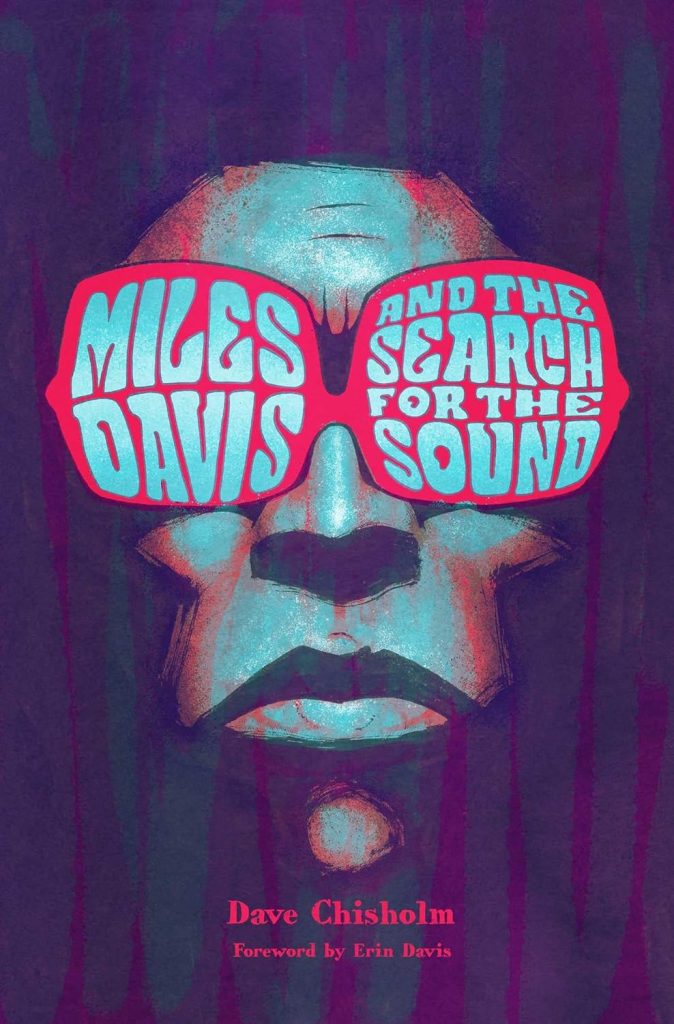Review by Frank Plowright
Miles Davis is a jazz titan, his influence and innovation stretching from the cool jazz era of the 1950s to 1980s hip hop. His massive reputation makes it surprising that he’s not been the subject of an English language graphic novel before now, but Dave Chisholm sets the bar extremely high for anyone who follows.
Chisholm approaches the task with deep respect, and as a man who plays the trumpet himself, having been inspired by Davis during the 1980s. The combination of musician and artist as creator provides a head start when facing the great stumbling block of effectively presenting music in comics. Chisholm delivers it as connected abstract shapes in bright colour rather than as notes, and that’s coupled with an intensity of expression as Davis holds his trumpet or listens in wonder.
Davis was known as reputationally difficult, yet nevertheless gave many interviews during his long career and also produced a brutally honest autobiography, which provide enough material for Chisholm to deliver a biography in Davis’ own words. He riffs around the edges via stunning illustrative interpretations, and importantly he doesn’t restrict matters to biographical facts, but rates Davis’ comments about music as of equal value, repeatedly accentuating the importance of playing off the right musicians. It’s enlightening, because despite being known for extemporising, Davis had a solid musical education and knew his form. To the musically untrained he’ll sometimes wander too far into technique with talk of flatted b’s, but anyone can pick up on the idea of there being no wrong note as it’s played because it’s what follows that makes it right or wrong. Exclusive use of Davis’ own words also avoids having to mitigate some unsavoury opinions and shoddy behaviour: he is as he presents himself, and that’s for better and worse, although Chisholm includes moments of women calling Davis on his bullshit. He’s also very self-aware, and strangely, like Charles Mingus, at one point refers to himself as being more than one person.
In his own way Chisholm is subtle as Davis. His layouts are thoughtful, and visual symbolism abounds, such as the messy tangle of lines seen page corners representing points where life begins unravelling. Years of heroin addiction are supplied in roughly juxtaposed panels with a searing red as the primary colour, and spatters of blood red around the edges, and the recording sessions of Kind of Blue are bathed in a pale blue light. That’s obvious, but Chisholm supplies it with such verve accompanying plain great illustrations. Those great illustrations feature throughout, in a variety of styles, with colour important for mood, and that of course is another echo of Davis.
Although categorised as a jazz musician, Davis deplored the label, and he’s shown as creatively restless, always moving onwards rather than repeating, a practical attitude when his sidemen constantly followed their own ambitions. Occasionally there’s a wish for a little more information – how does anyone’s car get hit by a train? -, but this is comprehensive and enlightening, and Chisholm selects exactly the right words at the end.
There’s a great shame about Miles Davis and the Search for Sound, though, and it’s that it’s unlikely to be read by anyone not attuned to Davis in the first place. It’s a constantly fascinating story of an undeniably brilliant man brought to vivid life by amazing art. It shouldn’t matter if it’s Puccuni, Pink Floyd or Public Enemy that pushes your buttons, this is a great graphic novel.





